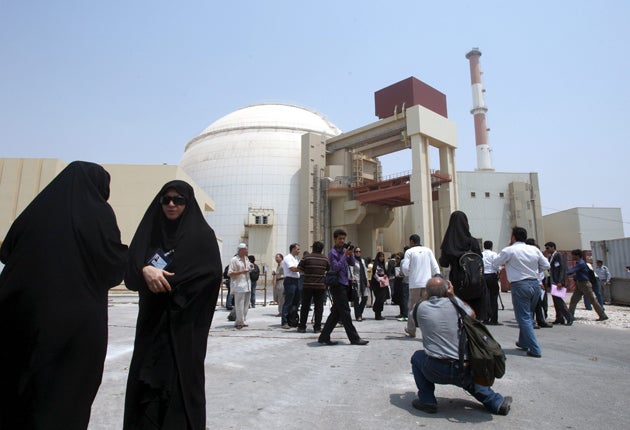West jittery as Iran completes its first nuclear reactor
Russia puts finishing touch to plant as experts warn of threat from uranium enrichment programme

Your support helps us to tell the story
From reproductive rights to climate change to Big Tech, The Independent is on the ground when the story is developing. Whether it's investigating the financials of Elon Musk's pro-Trump PAC or producing our latest documentary, 'The A Word', which shines a light on the American women fighting for reproductive rights, we know how important it is to parse out the facts from the messaging.
At such a critical moment in US history, we need reporters on the ground. Your donation allows us to keep sending journalists to speak to both sides of the story.
The Independent is trusted by Americans across the entire political spectrum. And unlike many other quality news outlets, we choose not to lock Americans out of our reporting and analysis with paywalls. We believe quality journalism should be available to everyone, paid for by those who can afford it.
Your support makes all the difference.Iran's ambitions to become a nuclear superpower edged closer to realisation yesterday, with the opening of the country's first energy-producing nuclear reactor.
The long-awaited project, dogged by opposition from the US since plans were first drawn up in the 1970s, is now complete.
Iranian and Russian engineers will spend the next two weeks loading fuel into the plant, near the city of Bushehr. More than 160 fuel assemblies – equal to 80 tons of uranium fuel – will be moved into the reactor core over the next fortnight. It will be another two months before the Russian-built 1,000-megawatt light water reactor starts generating electricity. Iran's nuclear chief, Ali Akbar Salehi, said yesterday: "Despite all the pressures, sanctions and hardships imposed by Western nations, we are now witnessing the start-up of the largest symbol of Iran's peaceful nuclear activities."
He added: "Today is a historic day."
Russia, which helped to finish building Bushehr, has pledged to prevent spent nuclear fuel at the site from being shifted to a possible weapons programme. After years of delaying its completion, Moscow says it believes the Bushehr project is essential for persuading Iran to co-operate with international efforts to ensure it does not develop nuclear weapons. But John Bolton, a former US ambassador to the UN, has expressed grave concerns about the move. "Iran is on the verge of achieving something that Saddam Hussein was not able to achieve, and that's getting a second route to nuclear weapons," he said last week. "It's a very, very significant step forward for the Iranian nuclear programme."
Mark Hibbs, a nuclear analyst at the Carnegie Endowment for International Peace, has warned that Bushehr will be the only power reactor in the world operating without its national government belonging to the International Atomic Energy Agency's Convention on Nuclear Safety. "Without Iran's participation in this convention, the outside world has no credible assurances that it is operating Bushehr in a manner reflecting internationally acceptable safety standards," he said.
However, any concerns over the Bushehr plant are overshadowed by continuing fears over Iran's controversial uranium enrichment programme – which could allow it to develop weapons-grade plutonium. The US is leading calls for Iran to cease its efforts to develop uranium enrichment, a matter that has been the subject of a number of UN Security Council sanctions.
The new power station is not considered a proliferation risk because the terms of the deal commit Iran to allowing Russia to retrieve all used reactor fuel for reprocessing. Spent fuel contains plutonium, which can be used to make atomic weapons.
Fears of spent fuel from the plant being used for military means were dismissed last night by the British expert Norman Dombey, the professor emeritus of theoretical physics at Sussex University: "The concern over Bushehr is a red herring and always has been. I remember when the US State Department was arguing against Bushehr, saying that Iran shouldn't have a light water reactor, at the same time as it was agreeing to furnish North Korea with light water reactors."
He added: "Bushehr poses no risk of proliferation. The reason is that the plutonium from a light water reactor is going to be contaminated with plutonium 240 and so it is not weapons-grade plutonium. No state has exploded plutonium originating from an electricity-generating light water reactor."
In an attempt to calm Israeli fears over Iran's nuclear capability, US officials claim that Iran is still some way off being able to develop a nuclear weapon. Gary Samore, President Barack Obama's top adviser on nuclear issues, said last week that it would take Tehran "roughly a year" to turn low-enriched uranium into weapons-grade material.
Nuclear experts are most concerned about Iran's stated plans, in defiance of existing UN sanctions, to build 10 new uranium enrichment sites inside protected mountain strongholds.
Iran's main existing uranium-enrichment facility is in an underground facility at Natanz, about 160 miles south-east of Tehran, surrounded by anti-aircraft batteries. And last year Western intelligence discovered another uranium enrichment facility being built inside former ammunition depots carved into a mountainside near the holy city of Qom.
In relation to this, Professor Dombey said: "While Iran's plans for Bushehr don't pose a proliferation problem, its enrichment plans do."
Join our commenting forum
Join thought-provoking conversations, follow other Independent readers and see their replies
Comments